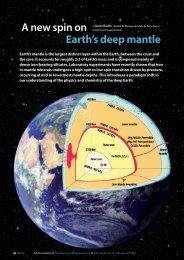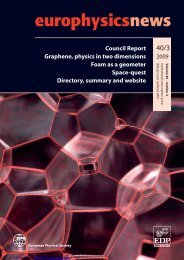PDF (11.37 MB) - Europhysics News
PDF (11.37 MB) - Europhysics News
PDF (11.37 MB) - Europhysics News
You also want an ePaper? Increase the reach of your titles
YUMPU automatically turns print PDFs into web optimized ePapers that Google loves.
HiSTory firST Solvay CounCil<br />
� fig. 2:<br />
Topics for the first<br />
Council, as listed<br />
in the letter of<br />
invitation,<br />
nHa, archive<br />
H.a. lorentz,<br />
inv.nr. 73. The<br />
corresponding<br />
rapporteurs are<br />
listed in our text<br />
in the order of<br />
these eight topics.<br />
experimental<br />
topics on blackbody<br />
radiation<br />
covered by<br />
warburg and<br />
rubens are not<br />
yet mentioned.<br />
The same holds<br />
for magnetism,<br />
langevin’s topic.<br />
� fig. 3:<br />
group picture of<br />
the second Solvay<br />
Council ‘Structure<br />
de la matière’,<br />
in the Solvay<br />
institute of<br />
Physiology,<br />
october 1913,<br />
reproduced with<br />
permission of the<br />
international<br />
Solvay institutes<br />
for Physics and<br />
Chemistry,<br />
founded by<br />
e. Solvay, brussels.<br />
16 EPN 42/5<br />
�<br />
toward the same limit at absolute zero. In order to find<br />
evidence for his theorem, Nernst started a programme<br />
of specific heat measurements in 1909. Promising<br />
results - down to liquid air temperatures - started accumulating<br />
in 1910. �ey agreed qualitatively with the<br />
Einstein formula, boosting thereby Nernst's confidence<br />
in ‘Einstein's quantum theory’.<br />
Early March 1910, Nernst - a major authority in Berlin<br />
- decided to pay a visit to Einstein, who was a relatively<br />
unknown associate professor in Zürich. Shortly a�er the<br />
meeting, Nernst expressed his enthusiasm in a letter [2]<br />
to his Manchester colleague,Arthur Schuster: "It was for<br />
me an extremely stimulating and interesting encounter.<br />
I believe that , as regards the development of physics, we<br />
can be very happy to have such an original young thinker,<br />
a ‘Boltzmann redivivus’; the same certainty and<br />
speed of thought; great boldness in theory, which however<br />
cannot harm, since the most intimate contact with<br />
experiment is preserved. Einstein's‘quantum hypothesis’<br />
is probably among the most remarkable thought<br />
constructions ever; if it is correct, then it indicates<br />
completely new paths both for the so-called ‘physics of<br />
the ether’ and for molecular theories; is it false, well,<br />
then it will remain for all times a ‘beautiful memory’”.<br />
On 1 April Nernst spoke in Paris, about his theorem, the<br />
results of his measurements and their agreement with<br />
Einstein's formula [3]. Stimulated by his findings and by<br />
his foreign contacts, Nernst conceived the idea of organizing<br />
a ‘Konzil’ on quanta, a ‘summit’, in other words a<br />
‘Concile’ or ‘Conseil’.<br />
Nernst's plan for a Konzil<br />
Nernst discussed his idea with Planck, Knudsen and<br />
Lorentz. �ey agreed to participate, but Planck preferred<br />
to wait one more year for the emergence of new<br />
elements that would even increase the crisis. He also<br />
expressed concern about the proposed list of participants,<br />
indicating that most of them would not be<br />
seriously interested in the subject. In spite of this, Nernst<br />
decided to go ahead with the help of his Belgian collaborator<br />
Goldschmidt, a chemist, an inventor and a<br />
personal acquaintance of Solvay.<br />
Early in July 1910 Nernst met the industrialist at Goldschmidt's<br />
home in Brussels. Later that month he<br />
submitted a detailed proposal for a Konzil, asking Solvay<br />
to throw it in the waste-paper basket in case of disapproval.<br />
�e proposal contained a letter of invitation<br />
which Solvay only needed to sign.<br />
Nernst also insisted for not being named as the initiator of<br />
the project. He was obviously eager to have the quantum<br />
theory discussed by internationally recognized authorities,<br />
brought together on neutral ground by a fair-minded<br />
patron of science. Brussels seemed therefore perfectly<br />
suited. Solvay accepted the proposal, but asked for some<br />
deferment. Meanwhile, several alterations were made in<br />
the list of invited members and in the Council's chairmanship.<br />
For instance, Solvay wanted to have a balance<br />
between the numbers of German,French and British participants.<br />
When Lorentz became the chairman, in May<br />
1911, he arranged for Kamerlingh Onnes to be invited.<br />
Why did Nernst's name show up on the letter of invitation?<br />
Quite simply because Goldschmidt le� for the<br />
Congo, in June 1911, to set up wireless telegraphy, at King<br />
Albert's request. �e irritated Nernst had no other choice<br />
than to take care himself of the correspondence.<br />
The Council in hotel Métropole<br />
Among the 23 invited members,five chose to stand aside:<br />
Larmor, Lord Rayleigh, Schuster, �omson and Van der<br />
Waals. Goldschmidt, M.de Broglie and Lindemann,<br />
Nernst's British collaborator,acted as secretaries.Opening<br />
speeches were delivered by Solvay, Lorentz and Nernst.<br />
11 reports and a letter from Rayleigh were discussed,<br />
five on black-body radiation and six on the properties<br />
of matter. �e rapporteurs were: Lorentz, Knudsen, Perrin,<br />
Jeans, Planck, Einstein, Sommerfeld, Nernst,<br />
Warburg, Rubens and Langevin. �e proceedings<br />
appeared in 1912 under the title‘�e �eory of Radiation










